Abstract
The hoisting of prefabricated components (PCs) is a key step during the construction of prefabricated buildings. Aiming at the problems existing in the control of PC hoisting, an innovative hoisting management system framework based on the digital twin (DT) is established in this paper. The system framework comprehensively utilizes the building information model (BIM) and Internet of Things (IoT) to establish a digital twin model (DTm) for PC hoisting control and uses Dijkstra’s algorithm to conduct hoisting route planning according to the BIM data in the model. Meanwhile, long-range radio (LoRa) technology was used for data acquisition and transmission to monitor the movement state of the PCs in the hoisting process. By testing it in a prefabricated building project, the DT control method was conducted to realize the functions of real-time information collection, hoisting path planning and PC positioning, which proved the feasibility and effectiveness of the method. As a key technology to realize intelligent manufacturing, DT has been widely studied in academia. The DTm of the hoisting process of PCs is established in this study; it improves the level of intelligent management of prefabricated building construction and provides a new idea for intelligent building construction.
1. Introduction
With the rapid development of society, the construction industry’s labor-intensive construction noise and pollution, as well as other problems, are increasingly prominent. Prefabricated building is developing rapidly because of its advantages of factory prefabricated component production, fast construction site assembly and green environment protection [1]. At present, the scale of the global prefabricated building market is growing steadily year by year and the new construction area and market share of prefabricated building in China are increasing year by year. Although prefabricated buildings have many advantages, there are still many challenges in the construction site of prefabricated buildings, such as insufficient management of construction site information being unable to be timely transmitted, insufficient management of PC and low degree of visualization of the construction site [2]. Prefabricated building is the key link to realize the transformation of the construction mode from the traditional way to the industrial way. How to use intelligent management and advanced technology to solve the problems in the construction of traditional prefabricated buildings has attracted the attention of enterprises and scholars [3]. Zhong et al. [4] developed a multi-dimensional BIM platform by applying radio frequency identification (RFID) technology and BIM technology to enhance the real-time visibility and traceability of PCs. Zhao et al. [5] proposed a method based on the combination of cloud computing, BIM and IoT to solve the problem of delayed information transmission on the construction site. Through RFID, wireless sensor networks, LoRa, BIM and cloud computing, real-time dynamic assembly building project data are obtained from the construction site. Bortolini et al. [6] established a prefabricated building system model based on BIM 4D modeling for assembly logistics planning and control in the construction site, which is used for the delivery of sequence planning of PCs in the construction site and the collaborative work of all construction parties. Ko et al. [7] proposed a cost-effective material management and tracking system based on integrated RFID cloud computing services, which realizes the omni-directional automatic tracking of materials. Dave et al. [8] developed a communication framework based on the IoT to strengthen lean construction management and the use of tracking technology for RFID, GPS and other key components of the IoT and to track the whole process status of workers, materials and equipment. Valero et al. [9] introduced the application of RFID technology in tracking the status of PCs and Lee [10] designed a conceptual framework for prefabricated building construction management systems, integrating BIM, 3D laser scanning, IoT, cloud computing and other information technologies, to improve the efficiency and quality of prefabricated building construction management. Wang et al. [11] proposed a conceptual framework of an Intelligent Construction System for Prefabricated Buildings based on the IoT (ICSPB-IoT) and proved the feasibility of the realization of ICSPB-IoT through case studies. Professor Ma and his team, on the basis of overall building information management, also conducted research on prefabricated buildings and put more emphasis on intelligence on the basis of informatization [12]. He established an intelligent production planning and control system for residential parts [13] and built a material management system based on mobile terminals for the construction site [14].
Based on the above research studies and analyses, it was found that there are, mainly, the following deficiencies: (1) Research on prefabricated building construction focuses on the application of new technologies, such as IoT and BIM, for site management and information transmission, but does not apply the IoT and BIM in the hoisting process of PCs. (2) Although there are studies on the hoisting of complex objects, such as complex environment, there is a lack of research on the control method for the hoisting of PCs. (3) There is a lack of systematic methods for real-time monitoring and visual display of PCs in the hoisting process. This study analyzes the application of a variety of emerging technologies in the field of prefabricated buildings, studies the application ideas of DT technology in the construction management of prefabricated buildings and establishes a multi-technology combination of a PC hoisting management method based on DT. Meanwhile, the key technologies of hoisting planning and monitoring of the hoisting process are studied in combination with a hoisting example; the feasibility of the proposed method was verified.
2. Literature Review
2.1. Prefabricated Building Construction Management
In the field of prefabricated building construction management, scholars have conducted extensive research on construction management digitalization and intelligent upgrade. Liu et al. [15] and Liu et al. [16] used low-power wide-area network (LPWAN) in prefabricated building construction sites to solve the problems of small coverage, high energy consumption, and real-time information uploading and query in wireless network used in traditional prefabricated building construction. By comparing LoRa and the narrow-band IoT (NB-IoT), the most concerned LPWAN LoRa technology was found to have advantages such as low cost, flexible networking, being independent of operators, lower energy consumption and more mature industrial chain [17]. Combined with the characteristics of multiple terminal nodes and small data volume, it is believed that LoRa technology is more suitable for prefabricated building construction sites. Wang et al. [18] proposed an enhanced perception system based on IoT to solve the hoisting problem. Zhou et al. [19] proposed to use CPS-SMS to simulate and monitor the hoisting process based on the concept of information physical systems (CPSs), which overcame problems such as limited vision of underground space crane operators and complex construction environment. Lee et al. [20] aiming at the problem of the blind field of vision of operators in the process of tower crane hoisting, proposed to use laser element ranging to accurately locate the position of the object to be lifted, thus ensuring the safety of the tower crane hoisting process due to visual field and other factors. In order to deal with the problem of crane hoisting path planning in complex environments, Cai et al. [21] proposed a hybrid configuration space collision detection strategy based on an image collision detection algorithm and designed a master–slave parallel genetic algorithm. Through the verification of Compute Unified Device Architecture (CUDA) programming on the graphic processing unit, this method could efficiently generate a high-quality hoisting path in the complex environment.
2.2. Digital Twin
With the rapid development of the new generation of technologies represented by the IoT, big data, cloud computing, Blockchain and artificial intelligence [22,23], the application of DT theory to solve the problems existing in intelligent manufacturing has gradually become a research hotspot. Globally speaking, the digitization level of the engineering construction field is at a low stage, far behind the manufacturing industry, which indicates that the digitization development of the construction industry has broad prospects and space. People’s Daily published an article on the broad prospect of DT and pointed out that, in the Yangtze River Delta integration Forum, relevant officials of the Ministry of Industry and Information Technology proposed to build a DT system for the full life cycle of products in key industries, which reflected China’s confidence and support for the application prospect of DT.
The concept of “twin” originated from National Aeronautics and Space Administration (NASA), which predicted the flight status of the air vehicle through the accurate simulation test of the “twin” aircraft on the ground [24]. Professor Michael Grieves proposed the concept of “Conceptual Ideal for Product Lifecycle Management (PLM)” and pointed out that the digital model corresponding to the physical product could abstract the state of the physical product by simulating and testing the product’s behavior [25]. It was not until 2011 that Professor Michael Grieves formally proposed the concept of DT, which includes physical entities, virtual digital models and the connection of data and information between them [26]. The DT conceptual model digitizes the concept of “twin”, introduces virtual space for digital expression and establishes the connection between real space and virtual space, enabling them to interact in real time [27]. DT refers to the establishment of a virtual model of the real physical entity in a digital way, so as to map the physical model in the real world to the digital world, and to the use of a virtual model to simulate the behavior characteristics of the real physical entity by means of information exchange, fusion and iterative optimization [28,29]. Based on the physical entity, virtual digital model and three-dimensional architecture of interactive connection, Tao Fei et al. [29] introduced the twin database and service platform to establish the five-dimensional DTm. Wu et al. [30] proposed a conceptual modeling method of DT based on the five-dimension DT framework to represent the complex relationship between DT and their attributes and conducted class verification through the concept level modeling of DT for intelligent vehicles. Pei Wang et al. [31] proposed a big data virtual and real fusion framework for intelligent manufacturing based on DT and designed the framework comprehensively from three perspectives, such as the overall framework supported by the industrial Internet. Qiu et al. [32] enumerated a typical AR assembly system structure, analyzed key technologies and applications of AR in digital assembly and pointed out that DT technology is the development trend of intelligent assembly research in the future. The authors of [33] studied the availability of data resources in the manufacturing industry based on DT and took the available and unavailable data in the turning process as an example to conduct general form classification to ensure that every situation was covered. Many researchers have studied the application of DT in the production workshop, aerospace and other intelligent manufacturing fields and put forward the concepts of DT workshop and DT satellite, which reflect the promotion of the development of advanced manufacturing industry by DT [34,35,36,37].
Research on DT is also increasing in the field of architecture. China Information and Communication Institute pointed out that the “DT city” is the necessary way and means to realize the “smart city”. The Chinese government is committed to making the Xiongan New Area a leading digital city in the world. Since the statement on DT cities was put forward in the 2018 outline of the plan for Xiongan New Area, DT cities have been mentioned in the fields of smart cities and community governance [38,39]. Yu et al. [40] proposed a method for health monitoring based on the DTm, which constructed a non-parametric Bayesian network to represent the dynamic degradation process of health state and the propagation of cognitive uncertainty. The authors of [41,42] studied the application of DT technology in steel structure building safety assessment and construction tensioning, respectively, verifying the feasibility of DT application through cases. In the field of building venue security, DT has been applied to the dynamic evacuation of personnel in the fire scene of the Winter Olympic Venues, which makes up for the shortage of traditional fire safety evacuations [43,44].
2.3. Research Emphasis and Novelty
Although information technology is widely used in the construction management of prefabricated buildings, the application of DT technology in the construction management of prefabricated buildings is seldom studied. Moreover, because of the complexity of construction and hoisting sites of PCs, it is impossible to collect and analyze the hoisting path and process information in real time. Additionally, because the management system of on-site construction hoisting cannot be combined with the existing virtual model layout, the management of construction hoisting still remains in the way of workers’ communication and dialogue. Thus, the construction site process cannot be better displayed. To solve these problems, this study uses BIM, IoT and other technologies to establish a DT model for the hoisting management of PCs. Meanwhile, the model was used to conduct meaningful investigations and the results are as follows: (1) According to the DT model, the system framework of construction hoisting management was established to realize the real-time interactive management of PC hoisting. (2) This study verified the feasibility of using Dijkstra’s algorithm to plan the hoisting path of PCs based on the established virtual model. (3) According to the system framework of virtual and real interactions, a method of real-time monitoring of the hoisting process of PCs is proposed to guide the management personnel in site construction. (4) Virtual model interactive management of PC hoisting management was realized to help site managers understand the location and related information of PCs. The method proposed in this study integrates DT, IoT, BIM and other technologies to improve the construction management level of prefabricated buildings, which is of great significance for future research.
3. DTm for PC Hoisting
According to the characteristics and requirements of PC construction and hoisting sites, this study establishes a DT five-dimensional model for prefabricated component lifting combined with the DT five-dimensional model proposed by Tao Fei et al. [27]. On this basis, the frame of a PC hoisting management system is proposed. As shown in Equation (1), HDT represents the hoisting-oriented DTm; HPE represents the hoisting of a physical entity, which mainly includes the component being hoisted, the surrounding physical environment affecting the hoisting and the actual changes in the component in the hoisting process, such as the position and attitude; HVE represents the hoisting of virtual entities corresponding to the hoisting of physical entities, such as PCs, BIM models of building and surrounding site layout, etc.; HDD represents the twin data system for storing and processing all kinds of data, such as building information model, data collected by sensor, etc.; HSP represents the hoisting control service platform, which is used for various operations and presentations of the hoisting process visualization; and HCN represents the relationships established among the four parts.
As shown in Figure 1, the hoisting service platform is used to display the information in the hoisting site environment and the hoisting process of PCs. Combined with the path-planning algorithm, the planned hoisting route of PCs is displayed. The service platform receives the virtual entity model, PC hoisting route data, PC position data and PC attitude data in the twin data service platform. HVE is modeled manually according to HPE. BIM modeling is conducted by hoisting surrounding environment (including building and site layout, etc.) and PCs and the data of HVE are uploaded to HDD for storage and processing. Combined with the cloud database, HVE is uploaded to the cloud, which can be quickly inquired and viewed by the construction personnel. Meanwhile, the path optimization algorithm is used to optimize the PC construction path, determine the reasonable hoisting path and obtain the planning path data. During the hoisting process, the PCs are collected by a variety of sensor devices and uploaded in real time using LPWAN. HDD collects and stores all the data in the hoisting scenario, mainly including the following four types: (1) HVE data after modeling is completed; (2) multi-layer data collected by the sensor during hoisting; (3) through HVE data combined with the path optimization algorithm, each PC hoisting planning path data; and (4) PC information data.

Figure 1.
DT five-dimensional model for PC hoisting management.
Through the DT five-dimensional model for PC hoisting, the framework of the management system for PC hoisting is established in this study, as shown in Figure 2. Through HPE in real object environment, HVE is established for the visual display of PC hoisting. HVE is processed and path planning for the hoisting route of PCs is conducted. The information of the PCs in HPE in the hoisting process is collected through a variety of sensors. The collected data include position data, attitude data, stress–strain data, etc. The IoT is conducted to realize the real-time transmission of data in the hoisting process of PCs and the relationship between the variation in the hoisting process of PCs in HPE and HDD and HSP is established. HSP can provide the visual display of PCs for tower crane operators, managers and project leaders. HSP applies an intelligent algorithm to call and process the data in HDD, so as to present the virtual construction site, PC position information and attitude information at the platform end. HSP controls the swing of PCs in hoisting by setting the swing displacement threshold and the route offset threshold. When the threshold is exceeded, HSP gives a danger alarm to reduce the risks in the hoisting process of PCs.

Figure 2.
Framework of hoisting control method based on DTm.
4. DT-Driven Hoisting Management Framework Construction
Based on the concept of DT, this study establishes the connection between HPE and HVE through HDD and HSP and realizes the real-time interactive feedback between the real physical environment and the virtual digital environment. In the hoisting control management system established in this study, HPE mainly includes construction site environmental entities, PC entities, tower cranes and operators. The construction site environmental entities and PC entities are modelled and digitized by virtual entities through BIM modelling. The virtual digital environment also includes the collection of a variety of data by a variety of sensor devices, including attitude information data and position information data, and uploads to HSP through information transmission technology. By combining the HVE data of PCs for data processing, visual presentation is carried out in HSP. The position and attitude information displayed by the tower crane operator is used to assist decision making and operation, and real-time interactive feedback between HPE and HVE is realized. The information collection of PCs in the hoisting process adopts the Inertial Measurement Unit (IMU), GPS, RFID tag and other sensors. HPE should be adjusted accordingly with the change in HPE. If the building floor increases gradually, the hoisting virtual entity should be updated according to the actual change.
4.1. DT-BIM Model
Building information mainly comes from the BIM model, which highly integrates all relevant data in the building engineering project. Moreover, BIM, as a better information solution in the construction industry, has been widely applied. Based on the BIM model, this study establishes DT-BIM for hoisting. DT-BIM can realize the digital representation of HVE on HPE of construction sites, environmental entities and PC entities. Based on the BIM model in the design stage, the modelling of the surrounding environment and adjacent buildings should be conducted reasonably, so that the virtual entity can fully show the physical environment of the construction site, the construction field layout and the DT-BIM of the building. Meanwhile, reasonable modelling of the building model is conducted for all kinds of PCs that are hoisted on site and corresponding information is added into the model for unified information management of the PCs that are processed from the factory to the site construction and hoisting. The model of the PCs should be consistent with the entity of the PCs to fully display the information of the PCs in the hoisting process.
BIM model-type attributes are used to define common attributes of the same types of components, including section definition, geometric parameters and identification data information. The instance type is defined as each specific precast component model having unique attributes, including 3D graphics, dimension labelling, constraint mode, elevation and positioning, etc. In order to realize the clear presentation of the PC model in the BIM model, the PCs are named and coded in combination with the positioning and coding of components’ names in the BIM model.
The BIM model is light-weighted to retain the 3D shape information of buildings and surrounding environment, so as to reduce the amount of model data and reduce the calculation pressure. According to the BIM model, combined with the layout location of the tower crane on the construction site, the location of the PCs, the location of the reinforcement processing zone and the surrounding building model, unified integration and lightweight processing are conducted, so that the construction hoisting site can be more clearly presented in the simplified BIM model. In the light-weight treatment of the BIM model, only relevant information affecting the hoisting of PCs in the construction site should be retained, such as the key location of the construction site as well as adjacent buildings and layouts that have an impact on hoisting, etc. Information that has no influence on hoisting, such as the specification of reinforcement, reinforcement and concrete of all parts of the building, is removed to reduce the information of the BIM model. The DT-BIM model is transmitted to the cloud server through the Industry Foundation Classes (IFC) interface; then, WebGL technology is used to mount it on the web page, so as to see the spatial environment layout of the construction and hoisting site of PCs on smart phones, tablets and other mobile devices.
In order to meet the requirements of the route optimization algorithm for highly abstracted construction site environments, this study proposes a plane model method which simplifies the DT-BIM model into a hoisting path-oriented model. The plane model facing the hoisting path is presented in the form of a spatial topology structure. The vertical hoisting plane model is established through the hoisting position of the PCs and the installation position of the PCs, which mainly includes the hoisting point of the PCs, the installation position of the PCs and the layout relationship of buildings and adjacent facilities, as shown in Figure 3.
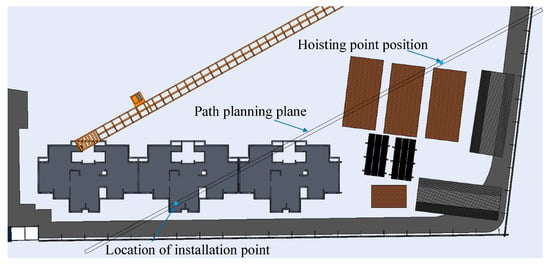
Figure 3.
Hoisting location schematic diagram based on DT-BIM model.
4.2. Hoisting Route Planning Based on Dijkstra’s Algorithm
According to the location of the PCs in the construction site, the path optimization algorithm is used to plan the hoisting path. According to the pre-developed building complex, the surrounding environment model and the principle of avoiding, the path is reasonably planned to establish the hoisting route from the storage location of the PCs to the installation point.
4.2.1. Prefabricated Component Hoisting Route Planning
This study takes the tower crane as an example to analyze the hoisting track of PCs and conduct hoisting route planning. In this study, the Dijkstra’s algorithm is employed for improvement and the condition function of prohibition is added to the node topology to prevent the hoisting route from passing through the obstacle body. The hoisting DT-BIM model is processed and the plane model topology diagram facing the hoisting path is obtained through hoisting point and termination point. The target building and obstacle body area in the topology diagram are the hoisting prohibition area and the hoisting prohibition condition function is set, as shown in Equation (2). The forbidden condition function means that the distance between any two points in the restricted area of hosting is infinite, wherein the variable T represents the horizontal coordinate and the variable V represents the vertical coordinate. The forbidden conditional function is used to eliminate the case whereby the node connection (hoisting path) in the topology diagram intersects with the obstacle body region, preventing the hoisting object from contacting the obstacle body region. In the topological diagram, the simplified size of the obstacle body extends outward for a certain distance, representing as the obstacle region, and the conditional function of the region is established.
4.2.2. Application Principle of Improved Dijkstra’s Algorithm
This section describes the principle of hoisting route planning of PCs in a construction site based on Dijkstra’s algorithm. Dijkstra’s algorithm adopts the pattern of a greedy algorithm, which is used to calculate the shortest path problem from one point to other points in a directed graph [44]. Its main feature is to extend the operation layer by layer from the starting point to the end point. The improved Dijkstra’s algorithm can calculate the shortest path from the hoisting point to the installation point in a given topology based on the avoidance principle. The idea of the improved Dijkstra’s algorithm is as follows:
(1) H = (S, U, E) is defined as a directed graph, where S is the set of nodes whose shortest path from source point to a node has been solved and U is the set of nodes whose shortest path has not been solved.
(2) If there is a node for the source point and the edge d (, ) that connects the two passes through the forbidden region (satisfies the forbidden condition function), then its path length is set to infinity. Meanwhile, if the slope of the side connecting source point to some node is less than 60 degrees, then the path length is set to infinity.
(3) The nodes in U are sorted according to the distance from the source point, the nodes with the minimum distance are transferred to set S and the nodes with the shortest path are recorded. Then, reorder the remaining nodes in U and select the node with the smallest distance.
(4) Repeat step 2. In the initial operation, there is only one point in S; find the shortest path each time and add it to set S, until all nodes are added to S and the algorithm ends.
In the above algorithm, the source points of the directed graph are updated according to the location of the PC and the directed graph and source points are updated according to the construction progress and the changes in the location of the PC.
4.3. Method of Monitoring the Hoisting Process of PCs
4.3.1. Fusion Algorithm Positioning in Hoisting Process
Based on acquisition layer sensor equipment such as RFID tag, IMU and GPS, it can collect detailed information of the components, position information and swing information in the process of assembly building construction in real time. The IMU is a device that measures an object’s three-axis attitude angle (or angular velocity) and its acceleration. By means of three uniaxial accelerometers and three uniaxial gyroscopes of IMU, the oscillation information of the prefabricated component in three-dimensional space is obtained and the attitude of the object is calculated accordingly.
There are various representation methods for attitude monitoring, including three common ones, i.e., Euler angle, attitude matrix and quaternion. In this study, the attitude solution algorithm based on quaternion is adopted. When the quaternion represents the attitude, there are multiple ways to write it. When the Euler angle represents the attitude transformation, it represents three rotations around three axes. According to Euler’s theorem, these three rotations can be equivalent to one rotation about one of the axes.
IMU was fused with GPS data and barometer data and the ETK (extended Kalman filter) algorithm was improved to monitor the hoisting trajectory of PCs. The algorithm architecture is shown in Figure 4. The improved fusion positioning algorithm architecture is shown in Figure 5. The fusion positioning algorithm fuses the data collected by IMU, GPS and barometer. The IMU collects the relative acceleration of the precast member in the hoisting process in real time, converts the coordinate to the absolute acceleration and obtains the three-dimensional displacement accumulation through two integrals. The collected angular rate is used to detect the stopping condition, information such as swing disturbance is zeroed and the quaternion is used to calculate the Euler Angle and the acceleration to monitor the swing. The above information collected by IMU forms a state matrix and Kalman filtering is carried out in combination with the position data collected by GPS and barometer, through which more accurate precast member position information can be obtained.

Figure 4.
Fusion positioning algorithm architecture.
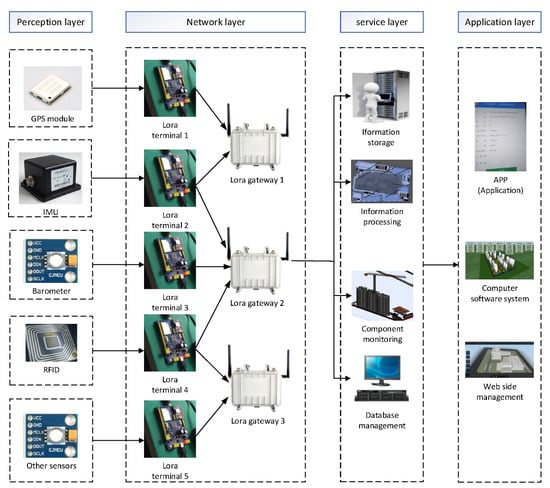
Figure 5.
Hoisting monitoring method architecture based on LoRa WAN.
4.3.2. Information Transmission Based on LoRa Technology
According to the DTm for PC hoisting, this paper establishes the connection between HPE and HDD based on the IoT, which involves wireless information transmission technology, sensor technology, global positioning system and RFID technology, etc. In recent years, the IoT has developed rapidly. As one of the IoT methods, LPWAN has attracted more and more attention from enterprises and scholars. By analyzing and comparing the existing wireless transmission technologies, it was found that LoRa technology has the advantages of wider transmission range and lower energy consumption. According to the characteristics of complex construction processes of prefabricated buildings and the advantages of LoRa technology, such as flexible networking and low costs, compared with NB-IoT technology, LoRa technology is more suitable for information transmission in prefabricated building construction and hoisting sites.
Based on the LoRa WAN network architecture, this study establishes the construction and hoisting site monitoring method architecture. LoRa technology is used for the wireless transmission of physical entity attitude information and position information during hoisting. In this study, the hoisting control terminal based on LoRa technology is used to transmit the information and data in the hoisting process wirelessly. The device has a variety of sensor interfaces, external IMU, GPS, barometer, etc. IMU collects attitude information, including acceleration, velocity, swing, etc., during the hoisting of PCs. IMU, GPS and barometer are used to collect the position information of PCs in the hoisting process through the fusion positioning algorithm. The collected information is transmitted in real time via the LoRa chip to the LoRa gateway, where it is uploaded to HDD. The connection between HPE, HDD and HSP is established through information collection, transmission and processing and the real-time feedback mechanism is established for visual display. As shown in Figure 5, the monitoring method architecture is mainly composed of perception layer, network layer, service layer and application layer. The perception layer refers to the information collection of the hoisting site through IMU, GPS, barometer, RFID tag and other sensors and information uploading through the LoRa terminal device. The network layer refers to the real-time and accurate transmission of the information collected by the perception layer through the LoRa network. The information collected by the perception layer is transmitted to the gateway through the LoRa WAN protocol and then to the service layer through the gateway. In the service layer, database technology is used to store and process the collected information, including component attribute information, hoisting monitoring information, etc. The information in the service layer can be displayed on apps and web pages through mobile phones, computers and other devices.
5. DT Application Case Study
Based on the DT theory and method, the framework of the control system for PC hoisting is established. In this system, the DT-BIM model of prefabricated building is embedded into the system, and the data collected by the sensor is also visually displayed at the HVE. The DT-BIM model and the data collected by the sensor are stored in HDD. According to these data and algorithms, component positioning, attitude monitoring, path-planning presentation and construction management functions are realized. In this study, the key technologies to realize these functions were experimentally studied and the above functions were preliminarily realized.
5.1. Application of Hoisting Route Planning Method
DT achieves accurate mapping of virtual and real objects that are similar in form, process and behavior by constructing virtual space objects corresponding to physical objects in physical space. By using digital twinning to achieve the accurate mapping of virtual and real conditions, we can have a more realistic grasp of the unpredictable situations in reality. The management method of twin hoisting based on twin PCs is shown in Figure 6. In this study, the real-time connection between the physical world and the virtual world for the hoisting of PCs was established through digital twinning and the dynamic interaction between the real situation and the virtual situation of construction hoisting process management was realized. At the same time, route planning and result prediction analyses of hoisting process were carried out through the interactive detection result analysis of processing architecture and algorithm. The mapping analysis of construction hoisting management is shown in the figure. Based on the concept of DT, this study started from model and data interaction, established the foundation of the virtual space model, perceiving and optimizing real-time information of physical entities, and promoted the technological integration and iterative integration of the BIM model, sensors, visualization software and IoT. In this study, the twin body mapping elements for prefabricated component hoisting were established, as shown in Figure 7. The driving factors of DT for the hoisting of PCs established in this study mainly include the following six aspects:
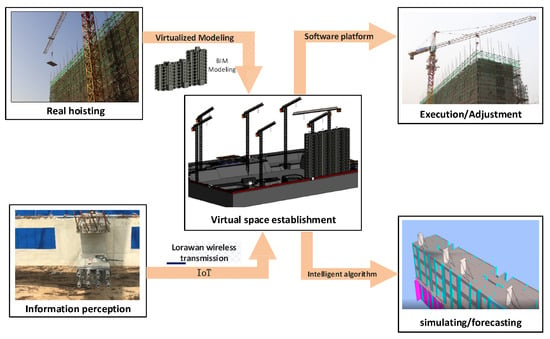
Figure 6.
Twinning management method of hoisting of PCs.
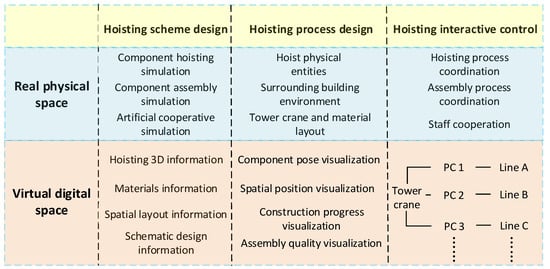
Figure 7.
Mapping elements of virtual-real twin for hoisting of PCs.
- (1)
- BIM model—a pre-established digital carrier of virtual mapping based on real physical space objects;
- (2)
- Sensor—actual hoisting process-related operation management and multi-dimensional and multi-level sensing tools;
- (3)
- Data—including data collected by sensors, construction plan data and historical reference data (physical list, design specifications, engineering drawings, on-site feedback, etc.);
- (4)
- Integration—the physical vehicle for the interaction between the physical and virtual digital worlds;
- (5)
- Analysis/Forecasting—analyze data through artificial intelligence algorithms and visualization programs and provide analytical decision-making and forecasting solutions;
- (6)
- DT—an accurate real-time digital model of the physical world.
This part takes the PC hoisting on the construction site of prefabricated buildings as an example, simplifies the DT-BIM (as shown in Figure 8) and preliminarily realizes the hoisting path planning with the improved Dijkstra’s algorithm. The hoisting point position and the installation point position were determined in the lift-oriented virtual model and the plane model of the prefabricated floor hoisting route was obtained. As shown in Figure 9, the hoisting planning plane was divided into prohibited zones. In the figure, the Prohibited Zone 1, where the target building is located, and the Prohibited Zone 2, where the steel processing zone is located, affected the hoisting this time. The prohibited area is a certain length of the external contour extension of the obstacle as a safety area to avoid collisions between PCs and obstacles in the hoisting process.
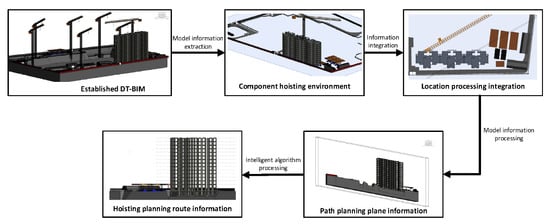
Figure 8.
Hoisting planning plane obtained by model cutting.
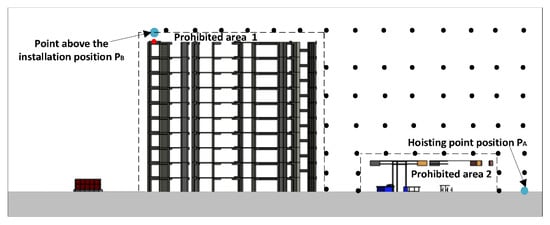
Figure 9.
Hoisting topology diagram of PCs.
The hoisting route node set was generated by generating the hoisting route node passing nodes in the hoisting topology diagram, as shown in Equation (3).
PL = {PA, P1, P2, P3,……, Pn−1, Pn, PB},
The hoisting path was planned by using the improved Dijkstra’s algorithm in Section 4.2. Firstly, the topology graph was represented by a topology matrix, in which the number represented the distance between its row node number and its column node number. The connected distance between nodes was expressed in the form of a matrix; then, the distance between nodes directly connected through the dangerous area was changed to infinity. This way, one can avoid collisions when using algorithms to calculate time paths. The established node topology matrix is shown in Figure 10. The data before and after algorithm optimization were compared and the results are shown in Table 1. It can be seen that the optimization effect was 27.369% when the safety angle of hoisting was not considered and 19.844% when the safety angle of hoisting was considered.
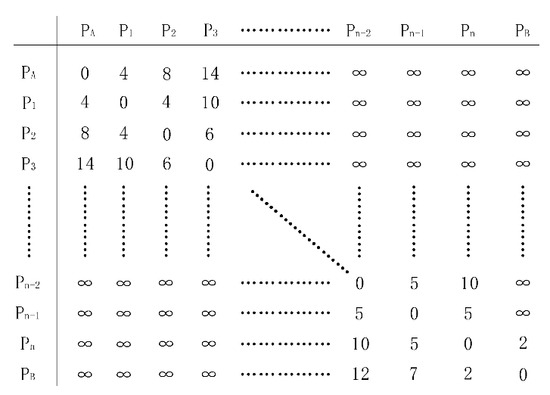
Figure 10.
Topology matrix of prefabricated component hoisting route planning.

Table 1.
Effect analysis table of hoisting route planning for a prefabricated floor.
5.2. Data Acquisition and Transmission Unit
In this study, a sensor was installed on the PC for data acquisition during the hoisting process and real-time monitoring of the PC during the hoisting process was conducted to ensure the safety and visibility of the PC during the hoisting process. In this part, BIM technology, LoRa technology and inertial measurement unit were combined to realize the monitoring of PC in the hoisting process. In addition, taking prefabricated building construction in Tianjin as an example, data collection, uploading and webpage display were conducted.
Information acquisition in this case mainly includes data acquisition in the hoisting process of PCs by sensors such as attitude sensor, stress sensor and GPS sensor. Based on LoRa technology, the PC hoisting monitoring information collection and upload terminal and transmission gateway were developed. The physical structure is shown in Figure 11. The transmission terminal was composed of an MCU control module, an LoRa module and various sensor interfaces. Information of hoisting process was collected and upload-ed by the acquisition terminal mentioned above. Figure 10 shows the acquisition terminal installed on the PC and its composition. The information collected by the acquisition terminal was uploaded through the LoRa gateway. The LoRa gateway applied on the construction site is shown in Figure 11.

Figure 11.
Physical view of LoRa information transmission terminal and gateway architecture.
In the case study, the BIM hoisting model established was exported in IFC format, which was parsed and read in the JavaScript environment for extension and light-weight processing, and the developed interface was used for transmission and uploading to HDD. Additionally, sensor information was transmitted to the system and combined with the twin model for visual display, so as to realize the retrieving of model data on the system platform or software and the viewing of the overall environment affecting hoisting in the construction site. The access process of the web terminal system is shown in Figure 12. Through the functional analysis of the system platform, it mainly included eight functional modules, including staff management, system management, site safety management, information entry, DT database management and DT model management. The contents of each module are shown in Figure 13.
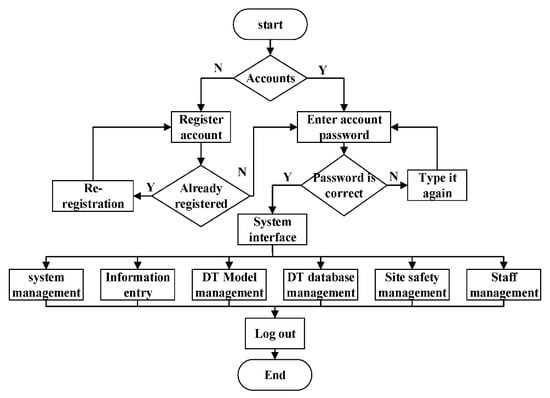
Figure 12.
LoRa gateway installed on the construction site.
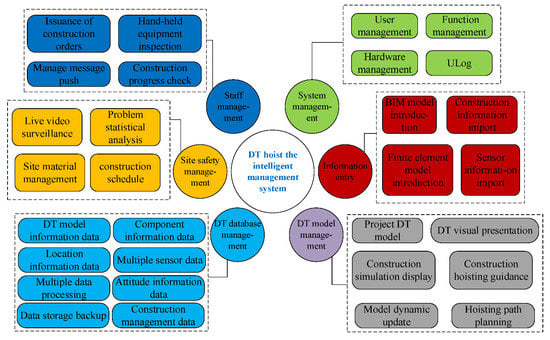
Figure 13.
Analysis of system platform functional architecture.
5.3. Prefabricated Component Hoisting Route Monitoring
The precast floor numbered T1-11-2-3 in the case study established the hoisting route planning plane of the floor through the hoisting position and the installation position and determined the hoisting route of the precast floor through the path-planning algorithm of this study, as described in Section 4.2. The construction and hoisting of the prefabricated floor were conducted according to the path planned by the algorithm and hoisting control was conducted according to the prefabricated floor information transmitted during the hoisting process. After receiving the instruction from the construction site, the manager of the component yard transported the components out according to the information in the system and re-entered the working state through the control transmission module of handheld devices for the real-time transmission of information. According to the information in the RFID spreader selection, floor ring inspection and other work, the correct hoisting needed to be checked. According to the information collected by the LoRa terminal during the hoisting process, the tower crane operator could view the real-time information of the components on the equipment and check the deflection, tilt angle and position information of the components during the hoisting process. The collected position information was processed and compared with the Kalman filtering effect, as shown in Figure 14. The position information directly measured by the sensor had a large error, especially the position of multiple projections. By comparing the position information of the three planes, it was found that the positioning accuracy was improved to a certain extent after the Kalman filtering correction of various sensors. By monitoring the location information of PCs, the tower crane was controlled timely to ensure that the components were lifted accurately to the installation point of prefabricated floor, thus improving the safety and visibility of the whole hoisting process.

Figure 14.
Hoisting route monitoring and comparison.
6. Discussion and Conclusions
Based on the concept of DT, this paper proposes the framework of a PC hoisting management system; furthermore, it intelligently controlled the hoisting process of PCs by using DT-BIM, IoT and sensor technologies. This study absorbed advanced technologies from other industries and applied them to the field of construction. An innovative solution is proposed for PC hoisting control, which has the following advantages.
(1) Aiming at the application method of assembly construction stage, the multi-technology integration mechanism of DT, IoT and BIM is explored. The twin feedback mechanism of virtual and real interaction provides a new idea for the realization of “real-time perception, intelligent analysis and intelligent decision” in the construction and hoisting management of PCs.
(2) In this study, DT-BIM hoisting planning model was established based on the DTm and hoisting path planning was carried out combined with the Dijkstra’s algorithm. This paper uses virtual space data to deal with the problem of hoisting paths and verifies the effect of the optimized hoisting path. The application of DT model was well verified by this method.
(3) LoRa technology and multi-sensor fusion method were applied to the construction site monitoring of prefabricated buildings, realizing the twin interactive connection of prefabricated construction and opening up the DT interactive channel. This paper uses the fusion location algorithm to process the data and confirms the effect of the depth information fusion on the optimization control of PCs in the process of hoisting, which is helpful to promote the intelligent development of prefabricated building construction.
(4) PC hoisting construction intelligentization is a multi-disciplinary integrated engineering system. This research project adopted DT technology, IoT, BIM and the integration method driven by an intelligent algorithm to realize the virtual and real interaction of hoisting management, which greatly improved the intelligent management level of PC hoisting.
Through the introduction of DT, IoT, BIM technology and sensor technology, strengthening the intelligent management and control of the assembly construction process is feasible and can improve the visual and intelligent level of site construction, so as to ensure the accuracy and safety of construction. Meanwhile, with a background of intelligent construction reform and industrial upgrading of construction industry, this study actively explores research and application schemes of DT, IoT and other technologies in the field of intelligent construction of prefabricated buildings, providing a good reference for future research.
Author Contributions
Conceptualization, Z.L; methodology, Y.Z.; software, Y.Z.; validation, Y.Z., Y.Z. and C.C.; writing—original draft preparation, C.C.; writing—review and editing, Y.Z.; project administration, Z.L.; funding acquisition, Z.L. All authors have read and agreed to the published version of the manuscript.
Funding
This research study was supported by the Deep Learning-Based Lifting Safety Risk Prediction and Control Method of Assemblies Building (8201001) of Beijing Natural Science Foundation.
Institutional Review Board Statement
Not applicable.
Informed Consent Statement
Informed consent was obtained from all subjects involved in the study.
Data Availability Statement
The data used to support the findings of this study are available from the corresponding author upon request.
Acknowledgments
The authors would like to thank Beijing University of Technology for its support throughout the research project.
Conflicts of Interest
The authors declare no conflict of interest.
References
- Arashpour, M.; Wakefield, R.; Blismas, N.; Minas, J. Optimization of process integration and multi-skilled resource utilization in off-site construction. Autom. Constr. 2015, 50, 72–80. [Google Scholar] [CrossRef]
- Li, Z.; Shen, G.Q.; Alshawi, M. Measuring the impact of prefabrication on construction waste reduction: An empirical study in China. Resour. Conserv. Recycl. 2014, 91, 27–39. [Google Scholar] [CrossRef] [Green Version]
- Liu, J.; Yi, Y.; Wang, X. Exploring factors influencing construction waste reduction: A structural equation modeling approach. J. Clean. Prod. 2020, 276, 123185. [Google Scholar] [CrossRef]
- Zhong, R.; Peng, Y.; Xue, F.; Fang, J.; Zou, W.; Luo, H.; Thomas, N.S.; Lu, W.; Shen, G.Q.P.; Huang, G.Q. Prefabricated construction enabled by the Internet-of-Things. Autom. Constr. 2017, 76, 59–70. [Google Scholar] [CrossRef]
- Zhao, L.; Liu, Z.; Jasper, M. Development of Intelligent Prefabs Using IoT Technology to Improve the Performance of Prefabricated Construction Projects. Sensors 2019, 19, 4131. [Google Scholar] [CrossRef] [Green Version]
- Bortolini, R.; Formoso, C.T.; Viana, D.D. Site logistics planning and control for engineer-to-order prefabricated building systems using BIM 4D modeling. Autom. Constr. 2019, 98, 248–264. [Google Scholar] [CrossRef]
- Ko, H.S.; Azambuja, M.; Lee, H.F. Cloud-based Materials Tracking System Prototype Integrated with Radio Frequency Identification Tagging Technology. Autom. Constr. 2016, 63, 144–154. [Google Scholar] [CrossRef]
- Dave, B.; Kubler, S.; Kary, F.; Lauri, K. Opportunities for enhanced lean construction management using Internet of Things standards. Autom. Constr. 2015, 61, 86–97. [Google Scholar] [CrossRef] [Green Version]
- Enrique, V.; Adán, A.; Carlos, C. Evolution of RFID Applications in Construction: A Literature Review. Sensors 2015, 15, 15988–16008. [Google Scholar]
- Lee, S.K.; Kwon, S. A conceptual framework of prefabricated building construction management system using reverse engineering, bim, and wsn. Adv. Constr. Build. Technol. Soc. 2014. Available online: https://www.iaarc-academy.com/download/CIB_IAARC_W119_CIC_2013_Proceedings.pdf#page=42 (accessed on 1 January 2022).
- Wang, X.; Wang, S.; Song, X.; Han, Y. IoT-Based Intelligent Construction System for Prefabricated Buildings: Study of Operating Mechanism and Implementation in China. Appl. Sci. 2020, 10, 6311. [Google Scholar] [CrossRef]
- Ma, Z.; Li, S. New Model of Project Management under the “Internet +” environment. J. Tongji Univ. Nat. Sci. 2018, 46, 135–139. (In Chinese). [Google Scholar]
- Ma, Z.; Yang, Z. Bim-based Functional Demand analysis of Intelligent Residential Parts Production Operation Planning and Control System. Civ. Archit. Eng. Inf. Technol. 2015, 7, 1–7. (In Chinese) [Google Scholar]
- Ma, Z.; Zhang, D.; Zhou, Q.; Liu, Z.; Yang, Z. Material management System of Subway Construction Site based on Mobile terminal and existing information System. Constr. Technol. 2012, 41, 5–9. (In Chinese) [Google Scholar]
- Liu, S.; Liu, Z.; Wang, W.; Zhao, Y. Application of NB-IoT Technology in prefabricated Building Construction Management. J. Civ. Eng. Manag. 2019, 36, 178–184. (In Chinese) [Google Scholar]
- Liu, Z.; Liu, S.; Wang, W.; Zhao, Y. An information solution for prefabricated building construction process based on low-power wide-area Internet of Things. Constr. Technol. 2018, 47, 117–122. (In Chinese) [Google Scholar]
- Froese, T.M. The impact of emerging information technology on project management for construction. Autom. Constr. 2010, 19, 531–538. [Google Scholar] [CrossRef]
- Wang, F.; He, F. Study of Hoist Perception System Based on IoT Technology. In Proceedings of the 2010 International Conference on Web Information Systems and Mining, Sanya, China, 23–24 October 2010; Volume 114, pp. 357–360. [Google Scholar]
- Zhou, C.; Luo, H.; Fang, W.; Wei, R.; Ding, L. Cyber-physical-system-based safety monitoring for blind hoisting with the internet of things: A case study. Autom. Constr. 2018, 97, 138–150. [Google Scholar] [CrossRef]
- Lee, G.; Kim, H.H.; Lee, C.J.; Ham, S.I.; Yun, S.H.; Cho, H.; Kim, B.K.; Kim, G.T.; Kim, K. A laser-technology-based hoisting-path tracking system for a robotic tower crane. Autom. Constr. 2009, 18, 865–874. [Google Scholar] [CrossRef]
- Cai, P.; Cai, Y.; Chandrasekaran, I.; Zheng, J. Parallel genetic algorithm based automatic path planning for crane hoisting in complex environments. Autom. Constr. 2016, 62, 133–147. [Google Scholar] [CrossRef]
- Zhang, J.; Shen, C.; Su, H.; Arafin, M.T.; Qu, G. Voltage Over-scaling-based Lightweight Authentication for IoT Security. IEEE Trans. Comput. 2021, 99, 1. [Google Scholar] [CrossRef]
- Li, B.; Liang, R.; Zhou, W.; Yin, H.; Cai, K. LBS Meets Blockchain: An Efficient Method with Security Preserving Trust in SAGIN. IEEE Internet Things J. 2021, 99, 1. [Google Scholar]
- Rosen, R.; Wichert, G.V.; Lo, G.; Bettenhausen, K.D. About The Importance of Autonomy and Digital Twins for the Future of Manufacturing. IFAC Pap. 2015, 48, 567–572. [Google Scholar] [CrossRef]
- Grieves, M. Digital Twin: Manufacturing Excellence through Virtual Factory Replication; Dassault Systèmes: Paris, France, 2014; Available online: https://www.3ds.com/fileadmin/PRODUCTS-SERVICES/DELMIA/PDF/Whitepaper/DELMIA-APRISO-Digital-Twin-Whitepaper.pdf, (accessed on 23 March 2015).
- Grieves, M. Virtually Perfect: Driving Innovative and Lean Products through Product Lifecycle Management; Space Coast Press: Cocoa Beach, FL, USA, 2011.
- Negri, E.; Fumagalli, L.; Macchi, M. A Review of the Roles of Digital Twin in CPS-based Production Systems. Procedia Manuf. 2017, 11, 939–948. [Google Scholar] [CrossRef]
- Tao, F.; Qi, Q.; Wang, L.; Nee, A.Y.C. DTs and cyber–physical systems toward smart manufacturing and industry 4.0: Correlation and comparison. Engineering 2019, 5, 653. [Google Scholar] [CrossRef]
- Tao, F.; Liu, W.; Zhang, M.; Hu, T.; Qi, Q.; Zhang, H.; Sui, Y.; Wang, T.; Xu, H.; Huang, Z.; et al. Digital Twin Five dimensional Model and its Application in Ten Fields. Comput. Integr. Manuf. Syst. 2019, 25, 1–18. (In Chinese) [Google Scholar]
- Wu, C.; Zhou, Y.; Pessôa, M.V.P.; Peng, Q.; Tan, R. Conceptual digital twin modeling based on an integrated five-dimensional framework and TRIZ function model. J. Manuf. Syst. 2020, 58, 79–93. [Google Scholar] [CrossRef]
- Wang, P.; Luo, M. A digital twin-based big data virtual and real fusion learning reference framework supported by industrial internet towards smart manufacturing. J. Manuf. Syst. 2021, 58, 16–32. [Google Scholar] [CrossRef]
- Qiu, C.; Zhou, S.; Liu, Z.; Gao, Q.; Tan, J. Digital assembly technology based on augmented reality and digital twins: A review. Virtual Real. Intell. Hardw. 2019, 1, 597–610. [Google Scholar] [CrossRef]
- Bazaz, S.M.; Lohtander, M.; Varis, J. Availability of Manufacturing data resources in Digital Twin. In Proceedings of the 30th International Conference on Flexible Automation and Intelligent Manufacturing (FAIM2021), Athens, Greece, 15–18 June 2021. [Google Scholar]
- Tao, F.; Zhang, M.; Cheng, J.; Qi, Q. Digital Twin Workshop—A New Mode of workshop Operation in the future. Comput. Integr. Manuf. Syst. 2017, 23, 1–9. [Google Scholar]
- Tao, F.; Cheng, Y.; Cheng, J.; Zhang, M.; Xu, W.; Qi, Q. Digital Twin Workshop Information physical Fusion Theory and Technology. Comput. Integr. Manuf. Syst. 2017, 23, 1603–1611. [Google Scholar]
- Liu, W.; Tao, F.; Cheng, J.; Zhang, L.; Yi, W. Digital Twin Satellites: Concepts, Key technologies and Applications. Comput. Integr. Manuf. Syst. 2020, 26, 565–588. [Google Scholar]
- Meng, S.; Ye, Y.; Yang, Q. Digital twin and its aerospace applications. J. Aeronaut. 2020, 41, 1–12. (In Chinese) [Google Scholar]
- CAICT—China Academy of Information and Communications Technology. What Does the Xiongan Digital Twin City and Smart City Look Like? Take a Look at Some Real-Life Example…. Available online: http://www.sohu.com/a/231025717_354877, (accessed on 8 May 2018).
- CAICT—Chinese Academy of Information and Communications Technology. The Third Symposium on Digital Twin Cities Was Held in Beijing. Available online: http://www.caict.ac.cn/xwdt/ynxw/201806/t20180625_175807.htm (accessed on 25 June 2018).
- Yua, J.; Songa, Y.; Tang, D.; Dai, J. A Digital Twin approach based on nonparametric Bayesian network for complex system health monitoring. J. Manuf. Syst. 2021, 58, 293–304. [Google Scholar] [CrossRef]
- Liu, Z.; Shi, G.; Zhang, A.; Huang, C. Intelligent Tensioning Method for Prestressed Cables Based on Digital Twins and Artificial Intelligence. Sensor 2020, 20, 7006. [Google Scholar] [CrossRef]
- Liu, Z.; Bai, W.; Du, X.; Zhang, A.; Jiang, A. Digital Twin-based Safety Evaluation of Prestressed Steel Structure. Adv. Civ. Eng. 2020, 2020, 8888876. [Google Scholar] [CrossRef]
- Liu, Z.; Zhang, A.; Wang, W. A Framework for an Indoor Safety Management System Based on Digital Twin. Sensor 2020, 20, 5771. [Google Scholar] [CrossRef]
- Liu, Z.; Zhang, A.; Wang, W.; Wang, J. Digital Twin Driven dynamic fire safety evacuation method for Winter Olympic Stadium. J. Tongji Univ. Nat. Sci. 2020, 48, 962–971. (In Chinese) [Google Scholar]
Publisher’s Note: MDPI stays neutral with regard to jurisdictional claims in published maps and institutional affiliations. |
© 2022 by the authors. Licensee MDPI, Basel, Switzerland. This article is an open access article distributed under the terms and conditions of the Creative Commons Attribution (CC BY) license (https://creativecommons.org/licenses/by/4.0/).